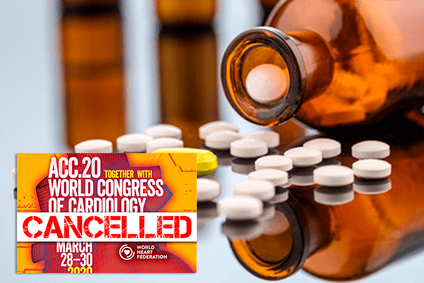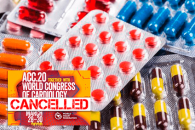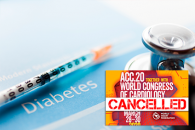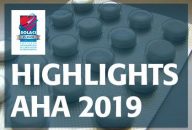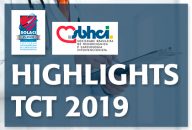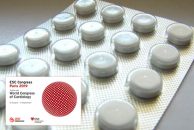Among patients hospitalized with life-threatening or uncontrolled bleeding under treatment with direct factor Xa inhibition, anticoagulation reversal with andexanet alfa (Andexxa) was associated with low mortality rates. These promising results have multiple limitations, particularly the lack of definition on bleeding severity. One of the studies testing the new antidote used propensity-score matching, and there were lower…
Virtual ACC 2020 | VOYAGER PAD: Rivaroxaban Superior to Aspirin in Preventing Events
In patients with peripheral artery disease undergoing revascularization, the combination of rivaroxaban (Xarelto) and low doses of aspirin are superior to aspirin alone in the prevention of acute low limb ischemic events, amputation, cardiovascular events and strokes. The outcomes of VOYAGER PAD add to the COMPASS outcomes, showing the combination of therapies can benefit risk…
Virtual ACC 2020 | COMPASS Sub-Analysis: Diabetes Increases the Benefit of Rivaroxaban Combined with AAS
In patients with stable coronary or peripheral artery disease, diabetes increases the benefit of combining low doses of rivaroxaban and aspirin vs. aspirin alone. This analysis was pre-specified in the COMPASS protocol and was presented virtually for the ACC 2020 and simultaneously published in Circulation. Patients with diabetes, showed numerically greater reduction in terms of…
Benefit of Anticoagulation in the Elderly with Atrial Fibrillation
Guidelines recommend oral anticoagulation for all ≥ 75-year-old patients with atrial fibrillation. However, there is little evidence as to its net clinical benefit in the elderly population. This study looked at the life net clinical benefit in atrial fibrillation patients over 75 years of age treated with warfarin or apixaban vs. no treatment. Researchers observed…
Net Benefit of Left Atrial Appendage Closure vs. Anticoagulation in Atrial Fibrillation
This analysis shows that the long-term clinical benefit of left atrial appendage closure with Watchman is superior to warfarin in patients with atrial fibrillation (AF). The initial peri-procedural risks of device implantation are counterbalanced over time, with reduced risk of bleeding and death. The PROTECT-AF (Watchman Left Atrial Appendage Closure Technology for Embolic Protection in…
AHA 2019 | GALILEO: Rivaroxaban After TAVI, Another Nice Theory that Clashes with Reality
In patients without formal indication for oral anticoagulation after successful transcatheter aortic valve implantation (TAVI), a treatment strategy including rivaroxaban 10 mg daily was associated with a higher risk of death or thromboembolic complications and, on top of that, a higher risk of bleeding than a conventional antiplatelet strategy. So far, we did not know whether…
AHA 2019 | GALILEO-4D: Rivaroxaban in the Prevention of Post TAVR Valve Thickening and Thrombosis
This sub study of the GALILEO specifically looked at valve thickening and reduced leaflet motion after TAVR documented with 4D CT. Whether anticoagulation with rivaroxaban might reduce or prevent this phenomenon remained unanswered. Patients receiving the same anticoagulation scheme than the general study’s (rivaroxaban + aspirin vs. aspirin + clopidogrel) were assessed by 4D CT…
Major Bleeding in Patients with Aspirin Plus Rivaroxaban
The combination of coronary artery disease or peripheral vascular disease and a reason for anticoagulation, such as atrial fibrillation, results in many patients who receive antiplatelet therapy with aspirin plus anticoagulation with rivaroxaban, for example. It is a well-known fact that this combination (aspirin 100 mg per day plus rivaroxaban 2.5 mg twice per day) reduces cardiovascular…
Major Bleeding in Patients with Aspirin Plus Rivaroxaban
The combination of coronary artery disease or peripheral vascular disease and a reason for anticoagulation, such as atrial fibrillation, results in many patients who receive antiplatelet therapy with aspirin plus anticoagulation with rivaroxaban, for example. It is a well-known fact that this combination (aspirin 100 mg per day plus rivaroxaban 2.5 mg twice per day) reduces cardiovascular…
TCT 2019 | AUGUSTUS ACS: Apixaban vs. Warfarin and Aspirin vs. Placebo in AF and ACS
Courtesy of SBHCI. The safety and efficacy of antithrombotic and antiplatelet treatments in patients with atrial fibrillation admitted with acute coronary syndrome (who receive medical treatment or angioplasty) may vary from that in patients undergoing elective treatment. At 14 days from elective angioplasty or hospitalization due to acute coronary syndrome, patients were randomized in a 2×2…
ESC 2019 | AFIRE: Monotherapy with Rivaroxaban in Atrial Fibrillation and Stable CAD
In patients with atrial fibrillation and stable coronary artery disease who have not had revascularization procedures in the last 12 months, monotherapy with rivaroxaban seems the best treatment strategy compared to rivaroxaban plus antiplatelet antiaggregation. This is what resulted from the AFIRE study, presented during the ESC 2019 in Paris and published in NEJM. Monotherapy…
